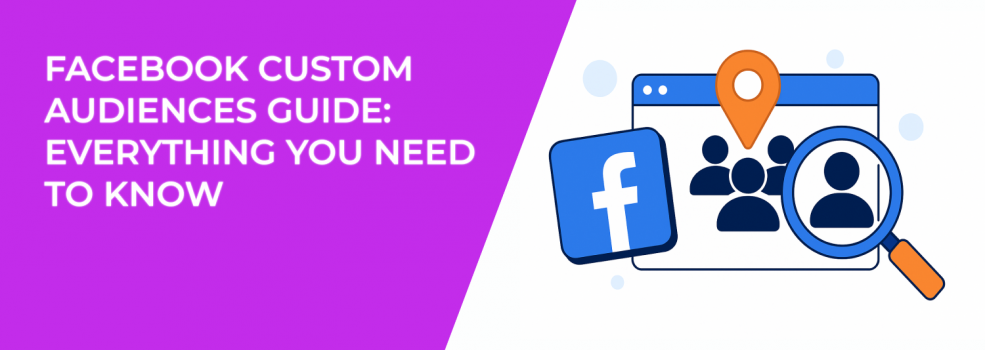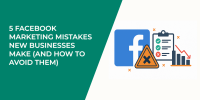Running Facebook ads isn’t just about creative visuals or catchy headlines. The real results come from showing your ads to the right people. If your targeting is too broad, you’ll waste budget. If it’s too narrow, you’ll miss growth opportunities. Facebook Custom Audiences help you strike the balance by focusing on people who already know your business.
In this guide, we’ll cover what Custom Audiences are, the different types you can build, how Advantage+ expands their reach, and some important pros and cons to keep in mind.
What Is a Facebook Custom Audience?
A Custom Audience is a targeting option inside Meta Ads Manager. It lets you reach people who have already interacted with your business in some way — maybe they visited your site, used your app, followed you on Instagram, or signed up for your emails.
This isn’t about starting from scratch. It’s about reconnecting with people who already showed interest. That’s why Custom Audiences often perform better than interest-based targeting.
Meta allows you to create up to 500 Custom Audiences per ad account, which means you can be very specific about who you want to reach.
If you’re new to Facebook targeting overall, check out this guide to Facebook Ad Targeting 101 for a bigger picture of how Custom Audiences fit into the ecosystem.
Types of Facebook Custom Audiences
Custom Audiences come from two main places: your own data and Meta’s built-in sources.
Your Own Sources
These are based on data you already have from your business:
-
Website traffic: Track visitors with the Facebook Pixel or Conversions API.
-
App activity: Retarget people who use your app.
-
Catalogue audiences: Build audiences based on product views or shop interactions.
-
Customer lists: Upload emails or phone numbers to match with Facebook profiles.
-
Offline activity: Use CRM or in-store purchase data.
These are strong because they connect directly to people who have already interacted with you. For example, targeting people who abandoned their cart often delivers high returns.
Meta’s Sources
If you don’t have much first-party data yet, you can build audiences from how people engage with your content on Meta platforms:
-
Video engagement
-
Lead forms
-
Instant Experiences
-
Shopping activity
-
Instagram account interactions
-
Event responses
-
Facebook Page engagement
-
On-Facebook listings
This is a simple way to start retargeting without a lot of setup.
Beyond Meta’s Options: Using LeadEnforce
Meta’s tools are powerful, but sometimes you need extra flexibility. LeadEnforce lets advertisers create Custom Audiences from Facebook group followers — something you can’t do inside Ads Manager alone. These audiences can then be shared directly with your Ad Account and used for campaigns just like any other Custom Audience.
This is especially useful if your audience is concentrated in niche groups or communities where traditional interest targeting falls short.
For more details, you might also want to read this post on how to build your target audience from a Facebook group.
Why Custom Audiences Work So Well
Custom Audiences focus on relevance. Instead of guessing who might be interested, you’re targeting people who already interacted with your brand. This usually means:
-
Better engagement and higher conversions.
-
Lower costs compared to cold targeting.
-
A stronger base for creating Lookalike Audiences.
Of course, the quality of your results depends on the quality of your source data. A clean email list or accurate Pixel tracking will outperform outdated or messy data.
Advantage+ Custom Audience: Pros and Cons
Meta has been rolling out Advantage+ custom audiences, which treat your Custom Audience as more of a guide than a strict rule. This gives Meta’s system freedom to show your ads to people outside your defined audience if it predicts better results.
This can be helpful, but it also means less control. Let’s look at both sides.
Pros
-
Scales your reach when your audience is small.
-
Finds cheaper conversions by expanding to similar users.
-
Uses automation to save time testing.
-
Good for top-of-funnel campaigns where precision isn’t critical.
Cons
-
Less control over who actually sees your ads.
-
Risk of over-expansion into irrelevant audiences.
-
Unstable performance for smaller advertisers.
-
Restricted use in special ad categories like housing, jobs, or finance.
Curious about whether automation like Advantage+ is worth it long-term? This breakdown of Meta Advantage+ vs manual setup explores the trade-offs in more depth.
Managing Custom Audiences
A big part of success comes from how you manage your audiences. Exclusions are especially important. For example:
-
Exclude current customers from campaigns aimed at new buyers.
-
Exclude past sign-ups when promoting a new webinar.
-
Exclude recent purchasers if you’re offering a discount for first-timers.
Regular updates are also key. Expired or deleted sources, like a removed Facebook Page, won’t work. Keep your lists clean and refresh your data often to avoid wasted spend.
For an in-depth look at why exclusions matter, see when to use exclude targeting on Facebook.
Lookalike Audiences: Expanding Beyond Retargeting
Once you have strong Custom Audiences, you can use them to build Lookalike Audiences. These find new people similar to your existing customers or leads.
Lookalikes are especially helpful when you’ve already maxed out retargeting. For example, creating a Lookalike of your top 5% of customers helps you reach new prospects who act like your best buyers.
The limitation? Lookalikes aren’t available for every ad category. If you’re running housing, employment, or financial ads, you may not have this option.
Tips for Smarter Custom Audience Strategies
Custom Audiences are only as good as how you use them. Keep these principles in mind:
-
Segment by intent. People browsing your blog and people who added items to their cart need different messages.
-
Test Advantage+ carefully. Don’t assume it’s always better — compare against standard targeting.
-
Use exclusions. They save budget and prevent overlap.
-
Watch opportunity scores. They can give ideas, but don’t treat them as guarantees.
-
Rotate creatives. Even great audiences burn out if you run the same ads too long.
Following these tips may sound straightforward, but execution is where most advertisers slip. Segmenting by intent requires you to think like your customer — what action signals genuine buying interest, and what signals casual browsing? Testing Advantage+ takes patience because short-term results can look volatile before patterns emerge.
Exclusions, while simple to set up, can completely change your campaign’s efficiency. Neglecting them often leads to wasted impressions or confusing ad journeys where the same person sees conflicting offers. And while opportunity scores in Ads Manager provide guidance, they should complement — not replace — your own analysis of cost per lead, ROAS, or conversion quality.
Finally, never forget the human factor: your audiences may be well-built, but stale creatives will make even the best targeting underperform. Keep content fresh, relevant, and aligned with the stage of the funnel each audience represents.
Final Thoughts
Custom Audiences remain one of the most reliable tools in Facebook advertising. They help you retarget people who already know your brand, improve efficiency, and give you a base for creating Lookalikes to scale.
Advantage+ adds flexibility, but it comes with trade-offs. Sometimes automation can lower costs, but sometimes it reduces control and weakens relevance. The smart approach is to balance both: use standard Custom Audiences when precision matters, and test Advantage+ when scale and reach are your main goals.
The bottom line? Custom Audiences let you spend smarter, not just bigger. By managing them well — and knowing when to expand or when to stay focused — you can turn Facebook ads into a more predictable growth channel.

